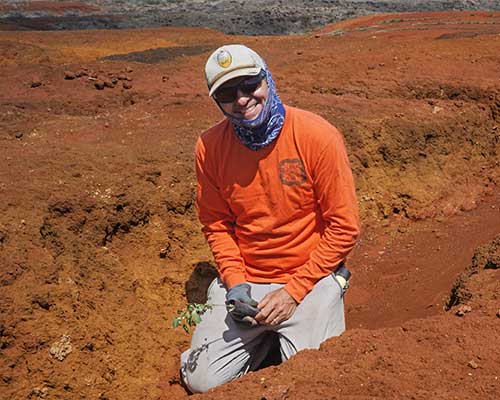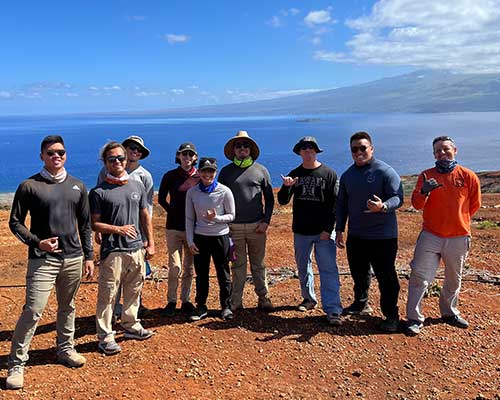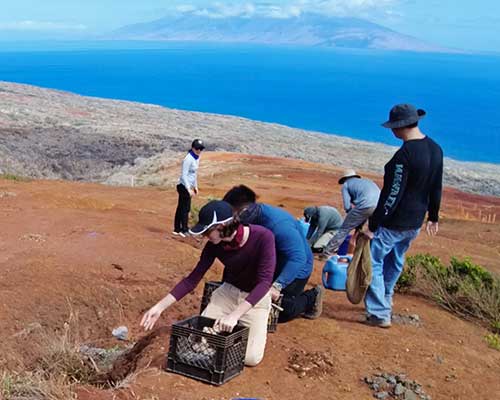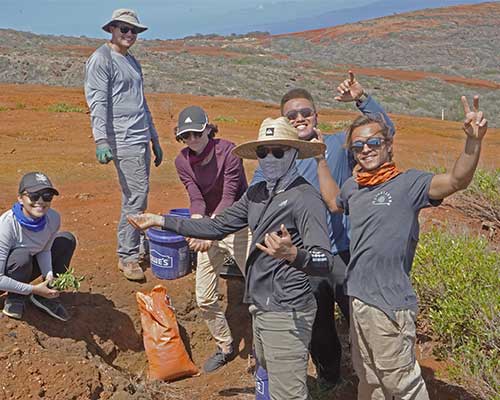A once-in-a-lifetime trip to Kaho‘olawe resulted in a major learning and bonding experience for a group of College of Social Sciences students.
Under the guidance of Professor Dave Beilman, nine capstone students in the Department of Geography and Environment spent four days volunteering on the sacred island with a controversial history. Kaho‘olawe was first used as ranch land and then by the U.S. military as a training ground and bombing range. The latter led to protests in the 1970s and was the start of Native Hawaiian focus that continues to this day.
The students gathered information, such as analyzing satellite images, historical aerial photographs and documents, and archaeological sites for their final capstone projects, along with performing maintenance work to the vegetation and roads.
“Kaho‘olawe is at the intersection of Hawaiʻi history, social justice, and environmental devastation and restoration. It’s been hugely rewarding to learn from and give back to the island with the students,” Beilman said.
During the trip from March 11–14, Skyler McMachen and other students helped remove invasive species, plant native species and performed general maintenance.
“Taking part in such a special and unique trip with my classmates was definitely a bonding experience. My most memorable moment was while planting native plants on the northern part of the island and looking out over the water and being able to see Lana‘i, Moloka‘i, Maui and tiny glimpses of the Big Island, all from a different perspective than most people get,” McMachen said. “For my project, I am looking at radiocarbon dates for archeological sites, so being able to see the island and the actual areas the sites were located was very helpful. It made it easier to visualize the area and where it is in relation to other sites.”
Beilman and the students worked closely with and received approvals for the expedition from the Kahoʻolawe Island Reserve Commission (KIRC) and Protect Kaho‘olawe ‘Ohana (PKO). KIRC was created by the state Legislature to manage the Kahoʻolawe Island Reserve while it is held in trust for a future Native Hawaiian sovereign entity. KIRC is administratively attached to the state Department of Land and Natural Resources. PKO is a grassroots organization dedicated to Kaho‘olawe and the principles of Aloha ‘Āina throughout Hawai‘i. PKO strengthens its relationship with the land and pays respect to the spirits of the land.
Māhie Lee’s research project is on ʻike kūpuna (ancestral insights, experiences and perspectives), and includes compiling a file of Hawaiian newspaper articles, songs and chants about Kahoʻolawe. Lee knew about PKO and its focus, but did not know about the current land agreement and the role of the state. She was very interested in seeing how KIRC operated on the island.
“The folks on the island were great. They were welcoming and gracious, and they went out of their way to answer all of our questions and take us to different sites around the island. It was evident that they respected the culture, the history, and their roles as stewards, not owners, of the land,” Lee said. “This was the ultimate learning trip, and I will remember and talk about it forever. I hope future geography capstone classes get to experience it as well.”
Christian Lamer-Wolfewicz’s project involves using satellite imagery and geographic information systems to determine how the climate events of El Niño and La Niña are impacting the vegetation health on Kahoʻolawe.
“Kaho‘olawe will be a very memorable experience for me. The staff at KIRC was very accomodating and they all had a wealth of knowledge that really showed that this commission really wants to preserve the history and heal the land so that future generations can continue the work,” Lamer-Wolfewicz said. “Going through this experience, I want to answer my research question and give some useful information to KIRC. After seeing the lack of vegetation in some areas and the efforts by KIRC to revegetate, it helped me narrow down what I needed to analyze.”
“The projects these students have developed provide an awesome example of the type of learning that can be done on Kaho‘olawe,” said Maggie Pulver, public information specialist for the KIRC. “The Reserve, and its many cultural, environmental, historical and geographical resources, provide an expansive classroom for students of all ages and disciplines. In fact, one of the goals outlined in I Ola Kanaloa!, the current strategic plan guiding active projects ‘on-the-ground’ in the Reserve, is to honor the natural environment and revitalization of cultural relationships through Kaho‘olawe by establishing programs for learning. These types of student partnerships directly contribute to that goal and help us to see what is possible when we look to place and culture for knowledge.”
Beilman and PhD student Charlotte Hipkiss, a CSS visiting scholar from the University of Southampton in the United Kingdom, previously went to Kaho‘olawe in February. To assist with KIRC restoration goals, the researchers installed a climate station and raised a sediment core from a coastal ephemeral wetland site, which will provide valuable information about changes to the climate and environment, and the past context for healing the site.
“The landscape over the island changes quite dramatically, as there are some areas that have trees and other plants growing. Then you’ll arrive at the work area and it’s just bare red soil as far as you can see, and then you can understand and see the long-term impacts of the grazing and bombing of the island,” Hipkiss said. “It is a very spiritual place. I was very grateful to be taken as part of the scientific team and be involved in this project. The KIRC team made us feel very welcome and it was great to work with them in this unique landscape.”
Beilman added, “From my perspective as a scientist and educator, Kaho‘olawe is a fascinating and special place. Our UH students won’t forget our service learning visit and the powerful experience of being hands-on in this sacred environment.”
Funding for the trip was provided by the Richard H. and Mildred D. Kosaki Student Assistance Endowment fund at UH Foundation . The endowment was established in 1996 to encourage undergraduate research with a special emphasis on the social sciences.



